
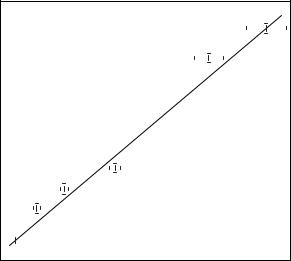
7. Electrophilic additions to dienes and polyenes |
555 |
isomerization either during the addition or the work-up (GC or fractional distillation) cannot be ruled out.
The addition of HCl to 1,3-butadiene in the gas phase at total pressures lower than 1 atmosphere and at temperatures in the range of 294 Ð 334 K yielded mixtures of 3-chloro-1-butene and (E)- and (Z)-1-chloro-2-butenes, in a ratio close to unity44,45. Surface catalysis has been shown to be involved in the product formation (Figure 1). The reaction has been found to occur at the walls of the reaction vessel with a high order in HCl and an order less than unity in diene. The wall-catalyzed process has been described by a multilayer adsorption of HCl, followed by addition of butadiene in this HCl layer. This highly structured process is likely to involve near simultaneous proton and chloride transfers.
Strong evidence for a -allylnickel complex as an intermediate in the nickel catalyzed addition of hydrogen cyanide to conjugated dienes46 has been obtained in a brief but clear-cut investigation of deuterium cyanide addition to 1,3-cyclohexadiene. This result has been of wide interest in relation to the mechanism of the industrial process for formation of adiponitrile in which two molecules of hydrogen cyanide added to butadiene via a three-step reaction catalyzed by nickel or palladium complexes (equation 15). The HCN addition to 1,3-cyclohexadiene in acetonitrile at 60 °C in the presence of Ni[P(OPh)3]4 with P(OPh)3 produced 2-cyclohexenecarbonitrile with high selectivity. The same reaction using DCN afforded the two monodeuteriated nitriles 10 and 11 resulting from 1,2- and 1,4-additions, in approximately equal amounts. The postulated mechanism (Figure 2), which is analogous to that previously established for the hydrocyanation of monoenes, involves the following steps. The active catalytic species, DNiL3CN
Rateo = −d[HCl]/dt. (105 mol h−1)
1.40
0.93
0.47
0
−10 12 34 56 Surface/volume ratio, (cm−1)
FIGURE 1. The variation in the initial rate of disappearance of hydrogen chloride (g) in the reaction of HCl with 1,3-butadiene as a function of the surface-to-volume ratio at 295 K. The initial concentrations of hydrogen chloride and 1,3-butadiene are 3.4 ð 10 4 M and 1.6 ð 10 4 M, respectively. (Reprinted from Reference 44, copyright 1991, with permission Elsevier Science)
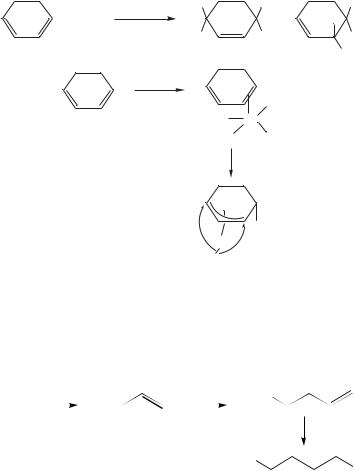
556 |
Cinzia Chiappe and Marie-Franücoise Ruasse |
[L D P(OPh)3] formed by oxidative addition of DCN to NiL4, coordinates one of the two double bonds of the diene. The coordination is followed by a cis-migration of the coordinated deuterium, producing a -allyl nickel complex in which a further cis-migration of the cyanide gave the two products 10 and 11.
|
H |
H |
H |
+ |
Ni[P(OPh)3]4 |
+ |
H |
DCN |
|||
|
60 ¡C, MeCN |
|
|
|
NC |
D |
D |
|
(10) |
(11) |
CN |
|
DNiL3CN |
|
|
|
|
D |
|
|
NC |
Ni |
|
|
L |
L |
|
cis-addition
10 + 11 + NiL2 
D
Ni

 L
L
NC
FIGURE 2. The mechanism of the nickel-catalyzed addition of hydrogen cyanide to 1,3-cyclohexa- diene. Reproduced by permission of the Royal Society of Chemistry from Reference 46
In an extension of an early work on the nickel-catalyzed addition of hydrogen cyanide to unsaturated compounds, a basic reaction in various large-scale processes in the polymer industry, the hydrocyanation of butadiene (equation 15) and the efÞciency of catalysis of this reaction by low-cost copper salts has been studied extensively by Belgium researchers47,48.
1 + |
HCN |
|
NC |
|
NC |
|
|
|
|
||
|
|
|
+ HCN |
(15) |
|
NC
CN
Copper-catalyzed monoaddition of hydrogen cyanide to conjugated alkenes proceeded very conveniently with 1,3-butadiene, but not with its methyl-substituted derivatives. The most efÞcient catalytic system consisted of cupric bromide associated to trichloroacetic acid, in acetonitrile at 79 °C. Under these conditions, 1,3-butadiene was converted mainly to (E)-1-cyano-2-butene, in 68% yield. A few percents of (Z)-1-cyano-2-butene and 3- cyano-1-butene (3% and 4%, respectively) were also observed. Polymerization of the oleÞnic products was almost absent. The very high regioselectivity in favor of 1,4-addition of hydrogen cyanide contrasted markedly with the very low regioselectivity of acetic acid addition (vide supra). Methyl substituents on 1,3-butadiene decreased signiÞcantly the efÞciency of the reaction. With isoprene and piperylene, the mononitrile yields were reduced
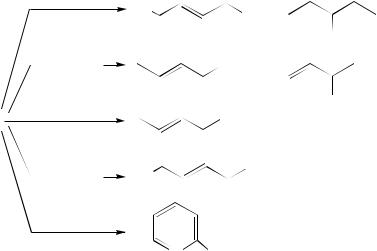
7. Electrophilic additions to dienes and polyenes |
557 |
to 39% and 12%, respectively, and the percent of polymerization increased. With two methyl substituents, polymerization was the exclusive reaction. Kinetic studies have established a key activating role of a variety of organic and inorganic bromides, crotyl bromide being the most efÞcient. Several mechanisms involving - or -allylcopper complexes, analogous to the well-established -allylnickel intermediates, have been proposed.
Oxycyanation27 affording 1,4-dicyano-2-butene occurred exclusively when the HCN addition was carried out under oxygen atmosphere (PO2 D 40 Ð 50 psig). In addition to the catalytic CuBr Ð LiBr system which works conveniently in the monohydrocyanation, the presence of cupric iodide has been found necessary in order to avoid the oxidation of HCN into cyanogen. With 1,3-butadiene, the yield reached 60%. Much lower yields have been found with 1,3-pentadiene (17%) and isoprene (3%) in acetonitrile solvent. In pyridine or DMSO, 2-cyanopyridine probably resulting from the addition of cyanide radicals has been formed from 1,3-butadiene in poor yield (15%). This observation has suggested a solvent-dependent competition between the ionic pathway leading to the dinitriles and a radical pathway responsible for the cyclization to the pyridine ring.
The similarities and differences between copper-catalyzed oxycyanation and diacetoxylation (vide supra), which are summarized in Figure 3, have been discussed. The main difference in the regiochemistry of the two reactions, i.e. an almost exclusive 1,4-addition in the cyanation and a non-regioselective acetoxylation, has been emphasized but was not interpreted in mechanistic terms.
The electrophilic addition of hydrogen sulÞde and 1-butanethiol to 1,3-conjugated dienes49 in chloroform at 10 °C has been reported in a quite old paper of a Russian team. The yields were generally low, in the range of 20%, even when the reaction was catalyzed by a mixture of two Lewis acids, EtAlBr2/EtAlCl2; however, polymerization of the diene was not signiÞcant.
HOAc / Ac2O
Cu(OAc)2−LiBr / O2
HOAc / Ac2O
Cu(OAc)2−LiBr / N2
HCN / CH3CN
1
CuBr−LiBr / N2
HCN / CH3CN
CuBr−LiBr−CuI / O2
HCN / DMSO
CuBr−LiBr−CuI / O2
|
|
% Yield |
AcO |
+ |
|
OAc |
75 |
|
|
|
OAc |
OAc |
+ |
|
60
|
OAc |
|
|
CN |
|
|
68 |
|
NC |
CN |
|
60 |
||
|
N |
15 |
CN |
FIGURE 3. Copper-catalyzed additions of acetic and hydrocyanic acids to butadiene. Reproduced by permission of Academic Press from Reference 27

558 |
Cinzia Chiappe and Marie-Franücoise Ruasse |
Depending on the linear, branched or cyclic structure of the unsaturated compound, a variety of dialkyl sulÞdes has been obtained in the reaction with H2S (equations 16 Ð 18). The regiochemistry depended markedly on the structure of the diene. For a mechanistic purpose, some experiments have been carried out using deuterium sulÞde, D2S. The results have been interpreted in terms similar to those of Nordlander and coworkers9 (vide infra). The thiylation of 1,3-dienes was assumed to start with a regiospeciÞc addition of a proton or a deuteron to one of the two double bonds to form two isomeric ion pairs as in equation 14 which, in the poorly dissociating solvent, collapse into products with equal probability.
|
H2S |
+ |
(16) |
|
1 |
|
|||
|
S |
S |
||
|
|
|
||
H2S |
(17) |
|||
S |
||||
|
|
|
||
|
|
|
S |
|
|
H2S |
(18) |
||
|
|
|
||
III. ELECTROPHILIC CARBENIUM IONS
In a review on the addition of carbenium ions to alkenes (equation 19) as a general procedure for carbon Ð carbon bond formation50, Mayr reported on investigations which also include the reactions of a variety of 1,3-dienes toward electrophilic carbon species generated by Lewis acid-promoted heterolysis of alkyl chlorides.
R+, BCl4− + |
|
|
+ |
|
|
|
|
|
|
|
|
|||||
|
|
|
R |
|
C |
|
C , Cl− |
|
R |
|
C |
|
C |
|
Cl (19) |
|
|
|
|
|
|
|
|
|
|||||||||
|
|
|
|
|
|
|
|
|
||||||||
As a general rule, alkyl-substituted 1,3-dienes reacted so that the corresponding allyl cation with the highest possible number of alkyl substituents at the cationic center was formed, leading to the regioselectivity51 indicated below. The subsequent nucleophilic addition to these cations afforded mainly mixtures of diastereoisomeric 1,4-addition products (>90%). An example is the reaction of p-methoxydiphenylcarbenium tetrachloroborate with 2-methyl- and 2,3-dimethyl-1,3-butadiene and 1,3-cycloalkadienes52,53. Nevertheless, some 1,2-addition products were also observed for 1,3-butadiene and 1-methyl-1,3-butadiene. This regiochemistry is in agreement with recent semiempirical AM1 calculations on the corresponding allyl cations54.
The kinetic behavior of 1,3-dienes has also been investigated in as much detail as that of alkenes52. Some data are collected in Table 4. The effect of a vinyl group on the reactivity of carbon Ð carbon double bonds toward p-methoxydiphenylcarbenium ion has been compared with that of methyl and phenyl substituents (Table 5). Whereas butadiene reacted 21 times faster than propene, the reactivity of isoprene was signiÞcantly lower
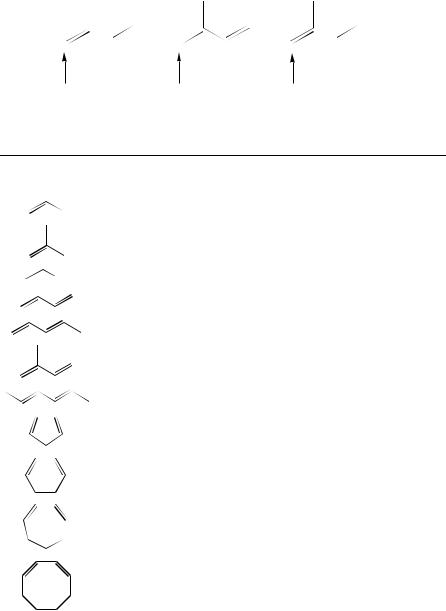
7. Electrophilic additions to dienes and polyenes |
559 |
Sites of attack by carbenium ions
TABLE 4. Rate constants and activation parametersa for the reactionb of p-methoxydiphenylcarbe- nium tetrachloroborate with various dienes
Compound |
k |
H6D |
SD6 |
kH3OC a |
|
(M 1 s 1 |
(kcal mol 1) |
(cal mol 1 K 1) |
(M 1 s 1) |
|
9.39 ð 10 4 |
7.8 |
33.3 |
2.38 ð 10 9 |
|
2.33 ð 101 |
5.0 |
26.8 |
3.71 ð 10 4 |
Ph |
1.09 ð 101 |
4.6 |
30.4 |
2.40 ð 10 7 |
|
1.93 ð 10 2 |
|
|
3.96 ð 10 3 |
|
4.62 ð 101 |
5.4 |
23.7 |
|
|
1.56 ð 101 |
5.5 |
25.4 |
3.19 ð 10 5 |
|
1.82 ð 102 |
3.6 |
29.7 |
|
|
1.74 ð 103 |
|
|
7 ð 10 7 |
|
2.75 ð 101 |
4.4 |
29.4 |
7 ð 10 6 |
|
3.04 |
5.3 |
29.4 |
1.4 ð 10 8 |
|
3.26 ð 10 1 |
|
|
3.5 ð 10 9 |
|
|
|
|
|
a Data from Reference 52 |
|
|
|
|
b At 70 ° C in dichloromethane.
c At 25 ° C; data from Reference 55
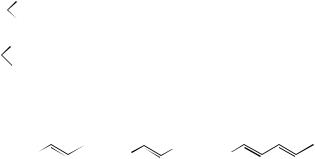
560 |
|
|
|
Cinzia Chiappe and Marie-Franücoise Ruasse |
|||||||
|
|
TABLE 5. |
Comparison |
of substituent effects on the |
|||||||
|
|
relative rates of carbenium ion addition to carbon Ð carbon |
|||||||||
|
|
double bonds |
|
|
|
||||||
|
|
|
|
|
|
|
|
|
|
|
|
|
|
Alkene/R |
Me |
CHDCH2 |
Ph |
||||||
|
|
|
|
|
|
|
R |
|
|
1.2 ð 104 |
|
|
|
|
|
|
|
|
H |
1.00 |
21 |
|
|
|
|
|
|
|
|
|
|
||||
|
|
|
|
|
|
|
|
||||
|
|
|
|
|
|
|
|
|
|
|
|
|
|
|
|
|
|
|
R |
|
|
|
|
|
|
|
|
|
|
|
|
1.00 |
0.67 |
62 |
|
|
|
|
|
|
|
|
|
|
|||
|
|
|
|
|
|
|
|
|
|||
|
|
|
|
|
|
|
CH3 |
|
|
|
|
|
|
|
|
|
|
|
|||||
|
TABLE 6. Effect of |
the methyl group at |
the electrophilically |
attacked vinylic carbon by |
|||||||
|
p-methoxydiphenylmethyl carbenium ion |
|
|
|
|||||||
|
|
|
|
|
|
|
|
|
|
|
|
|
|
|
|
|
|
|
|
R |
Ph |
R |
|
|
|
|
|
|
|
|
|
R |
|||
|
|
|
|
|
|
|
|
||||
|
kCH3 /kH |
|
|
|
1.3 |
0.36 |
3.9 |
||||
|
υ H6D (kcal mol 1) |
|
|
|
0.6 |
0.9 |
7.3 |
||||
|
υ S6D (cal mol 1K 1) |
|
|
|
2.6 |
6.0 |
27 |
||||
than that of isobutene. It is also noticeable that the effect of a phenyl group is much larger than that of the vinyl group. The effect of a methyl group at the initially attacked vinylic carbon atom depended also on the nature of the unsaturated system as shown in Table 6.
The similar order of magnitude of the reactivities of methyl-substituted 1,3-dienes (Table 4) which depended on the number but not on the position of the substituent was strong evidence that allyl cations55 serve as reaction intermediates in these reactions. The rate decrease with increase in the ring size of the cycloalkadienes was attributed to the increased deviation of the -system from planarity. The reactivities of 1,3-dienes deviated markedly from the roughly linear relationship between the rates of proton and carbenium ion additions to alkenes. These deviations were ascribed to abnormally low reactivity32 of the conjugated -systems, although this interpretation was inconsistent with the similar behavior of alkenes and dienes in the structure Ðreactivity relationship for hydration6.
IV. ELECTROPHILIC HALOGENS AND POSITIVE HALOGEN DONORS
A. General Aspects
The electrophilic addition of halogens, interhalogens and pseudohalogens to carbon Ð carbon double bonds, although extensively studied and repeatedly reviewed2, is still the object of kinetic and product investigations. The more recent studies, often concerning bromine additions3,7c, have revealed the complexities that underlie the simple representation generally given in organic chemistry textbooks1. The structure of the intermediate, the kinetics of the reaction, and both its stereochemistry and regiochemistry are all complex functions of the nature and concentration of the halogenating agent, of the solvent, of the added nucleophiles and of the structure of the alkene.
The Þrst step is usually the formation of a halogen ÐoleÞn charge transfer complex3c,7c, which rapidly evolves to an ionic intermediate. Protic solvents can electrophilically assist
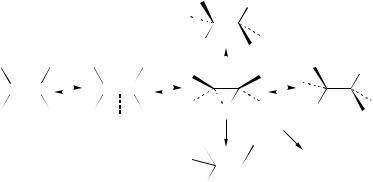
7. Electrophilic additions to dienes and polyenes |
561 |
the ionization process through hydrogen bonding. This is not possible in non-polar solvents, but further halogen molecules may assist in removing X as polyhalides. The cationic moiety of the intermediate may be a bridged or weakly bridged halonium ion, or a ˇ-halocarbenium ion, depending on the nature of the electrophile and on the oleÞn. Nucleophilic trapping of the intermediate by the counteranion, solvent or added nucleophiles yields the reaction products (equation 20).
|
|
|
|
|
|
|
|
|
|
|
|
|
|
|
|
|
|
OS |
|
|
|
|
|
|
|
|
|
|
|
|
|
|
|
|
|
|
|
|
|
|
|
|
Solvent (SOH) incorporation |
||
|
|
|
|
|
|
|
|
|
|
|
|
|
|
|
|
X |
|
|
|
|
||
|
|
|
k1 |
|
|
|
|
|
|
|
kE |
|
k′SOH |
|
|
|
X |
|||||
|
|
|
|
|
|
|
|
|
|
|
|
|
|
|||||||||
|
|
|
|
|
|
|
|
|
|
|
||||||||||||
nX2 + C |
|
C |
|
C |
|
C |
|
|
|
|
|
kN |
||||||||||
|
|
|
|
|
|
|
|
|
|
|
|
|
|
|
|
|
|
|
||||
|
|
|
|
|
|
|
|
|
|
|
|
|
|
|||||||||
|
k−1 |
|
|
|
+ |
(20) |
||||||||||||||||
|
|
|
|
|
|
|
|
|
||||||||||||||
|
|
|
|
|
|
|
|
k−E |
|
k−N |
||||||||||||
|
|
|
|
|
|
|
|
|
X2n |
|
|
|
|
|
X X2−n−1 |
|
|
|
X |
|||
|
|
|
|
|
|
|
|
|
|
|
|
|
|
|
|
|
|
|||||
Rearrangement
X
The regio-, stereoand chemoselectivities have been mainly interpreted in terms of bridging of the ionic intermediate and/or ion pair dissociation. Solvent-separated ion pairs and free ions have often been considered to explain the product selectivities of these reactions. Nevertheless, the stereochemical outcomes can also be determined by the relative rates of the ion pair dissociation and of the nucleophilic trapping of the intermediate, i.e. by the lifetime of the intermediate7d.
The rate laws for the addition of halogens are generally complex. Second, third and fourth overall order terms have been identiÞed (equation 21), depending on reagent and reaction conditions, solvent and added salts.
d[X2]/dt D [Alkene] k2[X2] C k3[X2]2 C k4[X2]3 C kX [X3 ] |
21 |
Furthermore, on the basis of the multistep mechanism reported in equation 20 and considering that the electrophilic and/or nucleophilic step may be rate determining depending on halogen and/or oleÞn, kobsd is always a composite constant (equation 22), even under the simpliÞed conditions where only one path contributes to the product formation and the reverse reaction (k N) does not occur.
kobsd D k1kEkN/ k 1k E C k 1kN C kEkN |
22 |
Since the structural factors and the solvent can affect the individual rate constants in ways which may differ in magnitude and sign, comparison of the experimental rate constants for various systems cannot always be straightforward.
B. Fluorine
Fluorine is the most electrophilic halogen and only few examples of controlled addition
of |
ßuorine to carbon Ð carbon double bonds have been reported56 Milder reagents, such |
as |
XeF2, are generally used to form ßuorine addition products. |
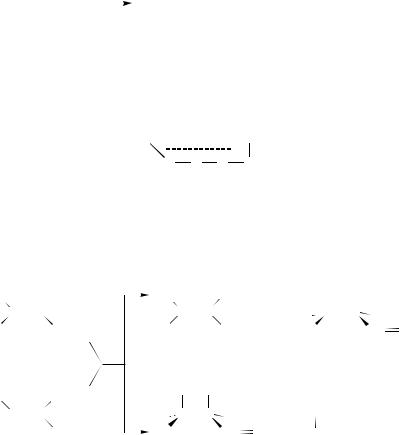
562 |
Cinzia Chiappe and Marie-Franücoise Ruasse |
The Þrst data about ßuorination of 1,3-dienes were reported10 by Shellhamer and coworkers, who described the additions of xenon dißuoride and (dißuoroiodo)benzene to butadiene, 2,3-dimethyl-1,3-butadiene and cis- and trans-1,3-pentadienes, in chlorinated solvents. Both reagents give 1,2- and 1,4-dißuoro adducts (equation 23). XeF2 yields primarily 1,2-products while C6H5IF2 gives signiÞcantly more 1,4-products.
|
|
R |
|
R |
|
|
|
|
R |
|
R |
|
|
|
|
R |
|
R |
|
|
|
||||||||
|
|
|
|
|
|
|
|
|
|
CH2 |
|
|
|
|
|
|
CH2 + CH2 |
|
|
|
|
|
|
|
|
|
|||
CH2 |
|
C |
|
C |
|
CH2 |
|
|
C |
|
C |
|
C |
|
C |
|
CH2 |
||||||||||||
|
|
|
|
||||||||||||||||||||||||||
|
|
|
|
|
|
||||||||||||||||||||||||
|
|
|
|
|
|
|
|||||||||||||||||||||||
|
|
|
|
|
|
|
|
|
|
|
|
|
|
|
|
|
|
|
|
|
|
|
|||||||
|
R = H |
|
F |
|
F |
|
|
|
|
F |
|
|
|
|
|
|
|
F |
|||||||||||
|
R = CH3 |
|
|
|
|
|
|
|
|
|
|
|
|
|
|
|
|
|
|
(23) |
|||||||||
The difference in the product distributions has been attributed to the steric effect of the counterion, X . The steric interaction between the large anion C6H5IF and the diene would favor the attack at the less-hindered C(4) atom of the intermediate 12.
|
X− |
|
F |
|
+ |
|
|
||
|
|
|
||
C4 |
C3 |
C2 |
C1 |
|
(12)
It is noteworthy that, at variance with bromination and chlorination which generally occur without isomerization of the disubstituted double bond, ßuorine addition to the 1,2- bond of cis- and trans-1,3-pentadienes gives mainly the trans-adduct 13, besides smaller amounts of compounds 14–16 (equation 24).
CH3 |
|
H |
|
CH3 |
H |
F |
|
F |
||||||
|
|
|
|
|
|
|
||||||||
C |
|
C |
|
C |
|
C |
|
+ CH3 C |
|
C H |
||||
|
|
|
||||||||||||
|
|
|
|
|||||||||||
|
|
|
||||||||||||
H |
|
CH |
|
CH2 |
|
H |
CH2CHF2 |
H |
|
|
CH CH2 |
|||
|
|
|||||||||||||
|
|
|||||||||||||
|
|
|
|
|
(13) |
|
|
|
(14) |
|||||
or
(24)
H |
H |
F F |
|
C |
|
C |
|
H |
C |
|
C |
H |
+ CH3CHCH |
|
CH |
|
CH2 |
|||
|
|
|
|
|||||||||||||
|
|
|
|
|
||||||||||||
|
|
|
|
|||||||||||||
|
|
|
||||||||||||||
CH3 |
|
CH |
|
CH2 |
|
|
|
|
|
|
|
|
|
|
||
|
|
|
CH3 |
(15) |
CH CH2 |
F |
(16) |
|
F |
|||||||
|
|
|
|
|||||||||||||
|
|
|
|
|
|
|
|
|
|
|
|
|||||
Thus, ßuorination of 1,3-dienes proceeds through an allylic ion, while weakly bridged halonium ions are the intermediates in chlorination and bromination of dienes (vide infra). Furthermore, starting from the experimental evidence that 13 is produced under kinetic conditions and not from subsequent rearrangement of the 1,2- and 1,4-adducts, the authors suggested that 13 arose from rearrangement of the allyl cation intermediate, 17. Consistent with an open ion pair intermediate is also the stereoselective formation of the threo isomer from both 1,3-pentadienes, as well as the preference for the addition to the 1,2- bond observed in the reaction of both isomeric pentadienes. This selectivity may indeed

7. Electrophilic additions to dienes and polyenes |
563 |
be related to a signiÞcant charge delocalization into the adjacent double bond in the rate-determining transition state, which favors the formation of intermediate 17 over 18.
|
|
|
|
|
X− |
|
X− |
||||||||||||
F |
|
|
|
|
|
|
F |
||||||||||||
|
+ |
|
|
|
|
+ |
|
|
|
|
|
|
|
||||||
CH2 |
|
CH |
|
CH |
|
CH |
|
CH3 |
CH2 |
|
CH |
|
CH |
|
CH |
|
CH3 |
||
|
|
|
|
|
|
|
|
||||||||||||
(17) |
|
|
|
|
(18) |
|
|
|
|
|
|||||||||
A different stereochemical behavior has, however, been observed in methanol57. In this solvent XeF2 reacts with the solvent to form an unstable reactive species (CH3OXeF), which gives quantitatively formaldehyde by disproportionation in the absence of unsaturated hydrocarbons or with unreactive alkenes. Hydrogen ßuoride generated in situ complexes the electrophilic CH3OXeF species to form a protonated derivative a which reacts with activated dienes such as 2,3-dimethylbutadiene, as an apparent ßuorine electrophile to give 1,4- and 1,2-ßuoromethoxy products, together with 1,2- and 1,4-dißuoro derivatives (equation 25).
|
H |
δ+ |
|||||
|
|
|
|
|
|
|
|
CH3O |
|
Xe |
|
F |
CH3O |
||
|
|
||||||
F− |
+ |
|
|
|
|
|
|
|
|
|
|
|
|
|
|
(a)
|
|
R |
|
R |
|
|
|
||
|
|
|
|
|
|
|
|
|
XeF2 |
CH2 |
|
C |
|
C |
|
CH2 |
|||
|
|
|
|
||||||
|
|
HF/MeOH |
|||||||
|
|
||||||||
|
|
|
|
|
|
|
|
|
|
RR
CH2  C C
C C  CH2 +
CH2 +
OCH3 F
11%
+
RR
CH2  C C
C C  CH2 +
CH2 +
FF 16%
δ−
Xe F BF3
(b)
RR
CH2  C C
C C CH2
CH2
FOCH3
35%
|
|
|
|
|
+ |
|
|
|
|
|
|
||
|
|
|
R |
|
|
R |
|
|
|
|
|
||
|
|
|
|
|
|
|
|
|
|
|
|
|
|
|
CH2 |
C |
|
|
C |
|
|
CH2 |
(25) |
||||
|
|
||||||||||||
|
|
|
|
||||||||||
|
|
||||||||||||
|
|
|
|
|
|
|
|
|
|
||||
|
|
|
|
|
|
|
|
||||||
|
|
|
|
|
|
|
|
|
|
|
|
|
|
F |
|
|
|
|
|
|
|
OCH3 |
|
||||
|
|
|
8% (E and Z) |
|
|||||||||
|
|
|
R |
|
|
R |
|
|
|
|
|
||
|
|
|
|
|
|
|
|
|
|
|
|
||
CH2 |
C |
|
|
C |
|
|
CH2 |
|
|||||
|
|
|
|
||||||||||
|
|
|
|
||||||||||
|
|
|
|
||||||||||
|
|
|
|
|
|
|
|
|
|
|
|
||
F |
|
|
|
|
|
|
|
F |
|
||||
|
|
|
|
|
30% |
|
|
|
|
|
|||

564 |
Cinzia Chiappe and Marie-Franücoise Ruasse |
Adducts of type 13, arising from the rearrangement of the allylic intermediate, have never been observed. The product distribution in methanol depends, however, on the reaction conditions. When the addition of XeF2 is carried out in the presence of boron trißuoride as a catalyst, the formation of the complex b has been suggested. This complex would react with 2,3-dimethylbutadiene as a positive oxygen electrophile to give, besides 1,2- and 1,4-dißuoro derivatives, 1,4- and 1,2-ßuoromethoxy products with a predominance of the anti-Markovnikov adduct (equation 26).
|
|
R |
|
|
R |
|
|
|
|
|
|
|
|
|
|
|
|
|
R |
|
|
R |
||||||||
|
|
|
|
|
|
|
|
|
|
|
|
|
|
|
|
|
|
XeF2 |
|
|
|
|
|
|
|
|
|
|
|
|
CH2 |
|
C |
|
|
C |
|
|
CH2 |
|
|
|
|
CH2 |
C |
|
|
C CH2 |
|||||||||||||
|
|
|
|
|
|
|
|
|
BF3/MeOH |
|
|
|||||||||||||||||||
|
|
|
|
|
|
|
||||||||||||||||||||||||
|
|
|
|
|
|
|
|
|
|
|
|
|
|
|
|
|
|
|
|
|
|
|
|
|
|
|
|
|||
|
|
|
|
|
|
|
|
|
|
|
|
|
|
|
|
|
|
|
|
|
|
|
|
|
|
|
|
|
|
|
|
|
|
|
|
|
|
|
|
|
|
|
|
|
|
|
|
|
|
|
OCH3 |
F |
|
|
|
|
|
|
|
||
|
|
|
|
|
|
|
|
|
|
|
|
|
|
|
|
|
|
|
|
|
|
|
|
30% |
|
|
|
|||
|
|
|
|
|
|
|
|
|
|
R |
|
R |
|
|
R |
|
|
R |
||||||||||||
+ |
|
|
|
|
|
|
|
|
|
|
|
CH2 + |
|
|
|
|
|
|
|
|||||||||||
|
|
|
CH2 |
|
C |
|
C |
|
CH2 |
C |
|
C |
|
|
CH2 |
|||||||||||||||
|
|
|
|
|
|
|
|
|
||||||||||||||||||||||
|
|
|
|
|
|
|
||||||||||||||||||||||||
|
|
|
|
|
|
|
|
|
|
|
|
|||||||||||||||||||
|
|
|
|
|
|
|
|
|
|
|
|
|
|
|
|
|
|
|
|
|
|
|
|
|
(26) |
|||||
|
|
|
|
F |
|
OCH3 |
F |
|
|
|
|
|
|
|
OCH3 |
|||||||||||||||
|
|
|
|
|
|
|
|
|
10% |
|
|
|
|
|
26% |
|
(E and Z) |
|||||||||||||
|
|
|
|
|
|
|
|
|
R |
R |
|
|
R |
|
|
R |
||||||||||||||
+ CH2 |
C |
|
C |
|
CH2 + |
CH2 |
C |
|
C |
|
|
CH2 |
|||
|
|
|
|||||||||||||
|
|
||||||||||||||
|
|
|
|||||||||||||
|
|
|
|
|
|
|
|
|
|
|
|
||||
F |
F |
F |
|
|
|
|
F |
||||||||
|
|
20% |
|
|
|
|
14% |
|
|
|
|||||
Furthermore, kinetic measurements have shown that the reaction is zero order in alkene when equimolar concentrations of XeF2, alkene and BF3 are used, whereas a dependence on oleÞn concentration is found when higher concentrations of alkene are utilized. On the basis of these kinetic data and taking into account that the regioselectivity of the reaction changes on increasing the oleÞn concentration, a mechanistic scheme has been proposed for this reaction in which two reaction pathways compete: in one the alkene is intercepted in a fast step, leading to both addition products and formaldehyde, and in a second one XeF2 reacts directly with the oleÞnic bond.
C. Chlorine
1. Conjugated double bonds
The Þrst studies of chlorine addition to the simplest diene, 1,3-butadiene, carried out in solvents of various polarity, showed58 that the reaction always led to mixtures of 1,2- and 1,4-addition products, in ratios almost independent of the solvent polarity. Furthermore, the addition of Cl2 in acetic acid gave, besides the 1,2- and 1,4-dichlorides, 3-acetoxy-4-chloro-1-butene and 1-acetoxy-4-chloro-2-butene arising from solvent incorporation (equation 27). By comparison of these data with those related to Br2 addition
